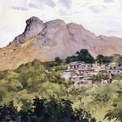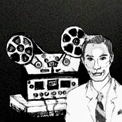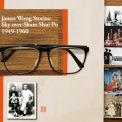Under the leadership of Sir Shaw Run-run, Shaw Studios sa w the burgeoning of a succession of several production units. Each unit was headed by a director who led a team of actors and production staff, and each produced works of a distinct style. Below are the behind-the-scenes stories which gave a more vivid picture of that era:
w the burgeoning of a succession of several production units. Each unit was headed by a director who led a team of actors and production staff, and each produced works of a distinct style. Below are the behind-the-scenes stories which gave a more vivid picture of that era:
Li Han-hsiang
Early in the period of Shaw & Sons Ltd., Shaw Run-de had already invited a number of southbound film personalities and intellectuals in Hong Kong, including Yen Chun, Teresa Li, Li Han-hsiang and King Hu, to help with the making of films. Among them, Li Han-hsiang was kind of a wandering, drifting intellectual during times of war. After he came to Hong Kong, he still immersed himself in the research of history and enjoyed the pleasure of collecting antiques. As he was trained as an art student, he was well versed in the techniques of art and drawings. During the Shaw Brothers era, he was already inspired by the Huangmei opera from the Mainland and persuaded Shaw’s to invest in the making of color period films with Huangmei opera singing elements. He could be said to be the pioneer of the Huangmei opera and period films in Hong Kong. On joining Shaw Brothers, he directed two films, The Kingdom and the Beauty (1959) and The Love Eterne (1963), which pushed the wave of Huangmei opera films to a peak.
Below is a series of photos taken at the filming location of The Love Eterne. In the photos, there was a small tower erected in Shaw’s studio. Inside the tower, there was Betty Loh Ti, who played the role of Chu Ying-tai. In addition, the outskirt scenery was also built in the studio for filming the scene where Liang Shan-po (played by Ivy Lin Po) and his boy attendant were hurrying on the way to pay a formal visit to a teacher for soliciting a place at his school. Lin Han-hsiang actually participated in designing the settings and costumes, and he even used a paint brush to retouch the sets. In the early-1970s, Li Han-hsiang left Taiwan and returned to Hong Kong, and thereafter, he reached another peak in his career by making period drama films, including The Empress Dowager (1975) and The Last Tempest (1976). In these film works, there were lots of sumptuous and gallant imperial settings, and Li Han-hsiang paid attention to every detail the objects used for props and sets, and to the design of costumes and hair styles. Below is a series of image photos of Lisa Lu, as Empress Cixi, and other actresses in The Empress Dowager. These photos helped the make-up artists and the hair stylists work out how the actors should look and facilitated the filming process. Li Han-hsiang was a director of versatility; apart from making Huangmei opera and period drama films, he also directed erotic films and comedies as well. He was an expert at mixing elements of refined and popular tastes, the beauty and the ugly into his films.
Studio filming of The Love Eterne (1)
Studio filming of The Love Eterne (2)
Studio filming of The Love Eterne (3)
Li Han-hsiang making props for The Love Eterne
Image record of hair styling design of The Empress Dowager (1)
Image record of hair styling design of The Empress Dowager (2)
Image record of hair styling design of The Empress Dowager (3)
Image record of hair styling design of The Empress Dowager (4)
Image record of hair styling design of The Empress Dowager (5)
Image record of hair styling design of The Empress Dowager (6)
Image record of hair styling design of The Empress Dowager (7)
Image record of hair styling design of The Empress Dowager (8)
Chang Cheh
Before turning to directing, Chang Cheh was a film critic. He had written a number of film critiques to express his discontent about the ecology of the Hong Kong film market in the late-1950s and early-1960s. He thought that there were quite a lot of popular films in Taiwan and Hong Kong at the time, but their themes and methods of portrayal were mostly too “feminine and soft”. And even the active actors were also very womanly, lacking of manly power. The movie circle seemed to be a stage solely for the performance of actresses, such as Teresa Li, Linda Lin Dai, Ivy Lin Po and others. With the dominance of feminine power and female stars, the number and starry attraction of the male stars were far outweighed by their female counterparts. Chang Cheh was deeply dissatisfied with this predominant feminine ambience of the movie circle.
After joining Shaw’s as director, Chang Cheh endeavoured to introduce new subject matters and helped Shaw’s promote the “new generation of martial arts” campaign. In addition, he selected film stories with themes of a more “manly” nature that highlighted the complicated emotions and relationships among the male protagonists. To present the manly themes of these masculine movies, Chang Cheh personally selected new faces and thereby promoted a macho image for a number of actors, such as Jimmy Wang Yu, Ti Lung, Chan Koon-tai and the like. Hence, as the macho movies prevailed, it was also time of glory for the male actors.
Below is a series of behind-the-scene photos of the action scenes of The Blood Brothers and The Heroic Ones. Chang emphasized the aesthetics of actions. In the photos, the actors were rehearsing the action sequence before filming. The story of The Blood Brothers was adapted from the intriguing case of “The Assassination of Ma Yixin” of the late-Qing Dynasty. The theme of the story was the conflicting nature of brotherhood and of gratitude and rivalry among brothers, indeed was a common theme of Chang’s movies. The story of The Heroic Ones, set in the Five Dynasties and Ten Kingdoms period, was based on the conflicts between the regional military-governor Li Ke-yong and his foster sons and commanders. In the film, one scene that caught the attention of the audience was the one in which actor John Chiang’s body was torn apart by 5 horses. The director made use of long shots and separate shots of each horse galloping to produce a shocking effect and thus created a macho and tragically heroic ambience.
Action scenes in The Blood Brothers (1)
Action scenes in The Blood Brothers (2)
Action scenes in The Blood Brothers (3)
Action scenes in The Blood Brothers (4)
Action scenes in The Blood Brothers (5)
Action scenes in The Blood Brothers (6)
Action scenes in The Blood Brothers (7)
The scene in which a body was torn apart by 5 horses in The Heroic Ones (1)
The scene in which a body was torn apart by 5 horses in The Heroic Ones (2)
The scene in which a body was torn apart by 5 horses in The Heroic Ones (3)
The scene in which a body was torn apart by 5 horses in The Heroic Ones (4)
The scene in which a body was torn apart by 5 horses in The Heroic Ones (5)
John Woo, who once worked as Chang Cheh’s assistant, admitted Chang Cheh’s deep influence on him in that the theme of fraternity was of high significance in his films. Hence, John Woo’s representative works, such as A Better Tomorrow and The Killer, were regarded by film critics as works which inherited Chang Cheh’s signature filming style and the theme of fraternity. In recent years, a number of Chang’s works, including The Blood Brothers and One-Armed Swordsman, were remade. Of the remakes, The Warlords, a movie based on The Blood Brothers and directed by Peter Chan Ho-sun, enjoyed both good acclaims and box office success in the Mainland film market.
Liu Chia-liang
Director Chang Cheh placed heavy emphasis on the realism of actions, so he brought in many martial arts masters to work as Director of Martial Arts for Shaw studios. Among them, Liu Chia-liang (or Lau Kar-leung) was a more renowned one.
With the assistance of Liu Chia-liang, Chang Cheh made a number of action films about the martial arts world of the South. In the late-1960s and early 1970s, Liu Chia-liang started to organize his own production team, and together with his blood brother Liu Chia-wing and his fraternity brother Gordon Liu, they formed the Lau’s Group to make action films for Shaw’s. Liu Chia-liang further explored the Shaolin legends of South China for martial arts-themed stories and then made The 36th Chamber of Shaolin and Return to the 36th Chamber, etc. These films emphasized the realism of combat actions, and the sets were filled with characteristics of the streets in South China. Below is a series of photos taken during the filming of The 36th Chamber of Shaolin by the Lau’s Group: the Liu’s Group at the worshipping ritual to inaugurate the filming; Gordon Liu having his hair shaved for the role Monk San De; during the filming of the scene in which Gordon Liu carried buckets of water to practice martial arts at the Shaolin Temple.
The Liu’s Group at the worshipping ritual
Hua Shan
In the early-1970s, as the TV stations purchased a lot of Japanese TV dramas for broadcasting, a Japanese trend prevailed in Hong Kong. In the mid-1970s, under the wave of Japanese superman dramas, the two big TV stations, “TVB” and “RTV”, broadcast many Japanese sci-fi TV dramas and cartoons in the afternoon session everyday and in the morning session at the weekends. The more renowned ones were “Iron King Kong”, “Kamen Rider” and “Mazinger Z”. Suddenly, various kinds of supermen, monsters and guardians of the universe overwhelmed the TV screens. Shaw’s director Hua Shan, trying to benefit from this wave, produced The Super Inframan. Hua mixed martial arts plots with sci-fi special effects to turn out a superman story with Chinese characteristics. The film had Ni Guang as Scriptwriter, Tang Chia as Director of Martial Arts and Danny Lee played the role of “The Super Inframan”. Besides filming on location at United College, CUHK, various monsters of the Ice Age, the devil lady with electric eyes and a huge monster were made with native methods inside Shaw studios. The fights between the Super Inframan and the different monsters were filmed using model with appropriate settings, resulting in varied and grotesque images with all kinds of possibilities for imagination. This was a classic of Hong Kong’s sci-fi films.
Studio filming of The Super Inframan
Below is a series of photos describing how Danny Lee, who played the role of “Super Inframan”, changed his appearance after the transformation. This was filmed against a backdrop made of fabric, and various “flying” stunt actions were posed with the help of a stand. Soon after the screening of this film, a student died after falling off a building while copying the superman’s flying action. After the accident, the academic circle vehemently attacked this type of sci-fi films and TV dramas, making this film the talk of the town.
Super Inframan before transformation





